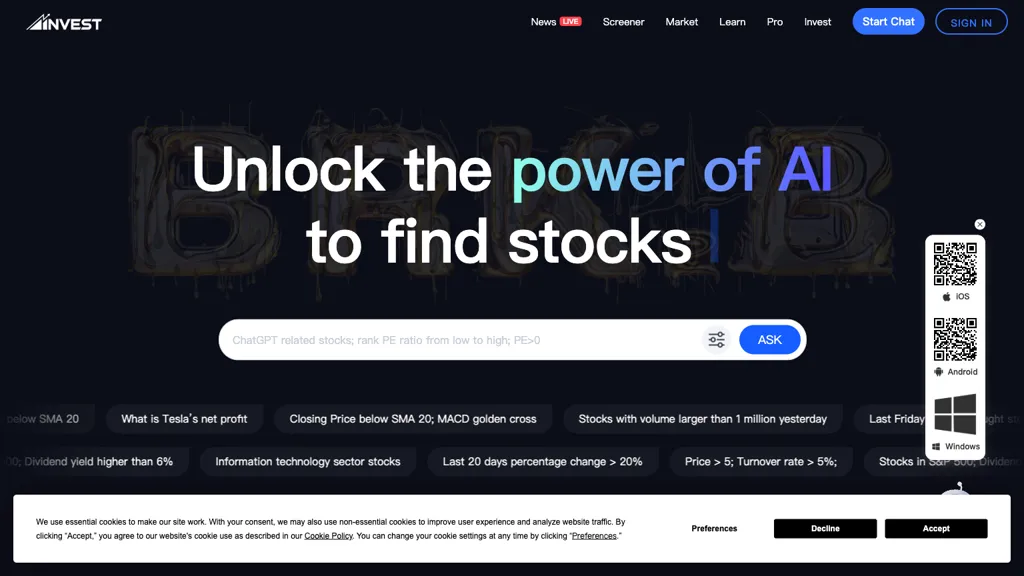20 Handy Advice To Choosing AI Stock Picker Platform Websites
20 Handy Advice To Choosing AI Stock Picker Platform Websites
Blog Article
Top 10 Things To Consider When Evaluating Ai And Machine Learning Models On Ai Stock Trading Platforms
To guarantee precise, reliable, and actionable insights, it is essential to assess the AI and machine-learning (ML), models used by trading and prediction platforms. Models that are not designed properly or overhyped could result in inaccurate predictions, as well as financial losses. Here are the top 10 guidelines to evaluate the AI/ML models used by these platforms:
1. Understanding the model's purpose and method of operation
It is crucial to determine the goal. Make sure the model has been designed to be used for long-term investment or short-term trading.
Algorithm transparency: See if the platform discloses the types of algorithms used (e.g. regression and decision trees, neural networks and reinforcement learning).
Customizability - Determine whether you can modify the model to meet your strategy for trading and your risk tolerance.
2. Review the Model Performance Metrics
Accuracy: Verify the accuracy of the model when it comes to the prediction of the future. However, do not solely rely on this metric since it can be misleading when used in conjunction with financial markets.
Accuracy and recall - Examine the model's ability to identify true positives and minimize false positives.
Risk-adjusted gain: See if the predictions of the model can lead to profitable transactions after accounting for the risk.
3. Make sure you test the model using Backtesting
Backtesting the model by using the data from the past allows you to test its performance against prior market conditions.
Testing using data that isn't the sample: This is crucial to prevent overfitting.
Analysis of scenarios: Check the model's performance during various market conditions (e.g., bull markets, bear markets high volatility).
4. Be sure to check for any overfitting
Overfitting Signs: Look out for models that do exceptionally well when they are trained, but not so with untrained data.
Regularization methods: Check that the platform doesn't overfit when using regularization methods such as L1/L2 and dropout.
Cross-validation. Make sure the platform is performing cross-validation to assess the model's generalizability.
5. Assess Feature Engineering
Relevant features: Find out if the model uses important features (e.g., price, volume emotional indicators, sentiment data, macroeconomic factors).
Select features with care It should include statistically significant data and not irrelevant or redundant ones.
Dynamic feature updates: Verify if the model adapts to new characteristics or market conditions in the course of time.
6. Evaluate Model Explainability
Interpretation - Make sure the model provides explanations (e.g. values of SHAP and the importance of features) for its predictions.
Black-box models: Be cautious of platforms that use overly complicated models (e.g. deep neural networks) without explanation tools.
User-friendly insights: Make sure the platform provides actionable information which are presented in a manner that traders can comprehend.
7. Examining the Model Adaptability
Market changes: Verify whether the model is able to adapt to market conditions that change (e.g. changes in regulations, economic shifts or black swan occasions).
Continuous learning: Make sure that the platform updates the model frequently with new data in order to boost the performance.
Feedback loops: Make sure the platform incorporates user feedback or actual results to improve the model.
8. Check for Bias or Fairness.
Data bias: Ensure that the training data you use is a true representation of the market and is free of biases.
Model bias: Determine if the platform actively monitors and reduces biases in the model's predictions.
Fairness - Make sure that the model is not biased towards or against certain sector or stocks.
9. Evaluation of the computational efficiency of computation
Speed: Check whether a model is able to make predictions in real-time with minimal latency.
Scalability: Determine whether a platform is able to handle many users and huge databases without affecting performance.
Resource usage: Make sure that the model is designed to make optimal utilization of computational resources (e.g. GPU/TPU usage).
10. Transparency and Accountability
Model documentation: Ensure that the platform is able to provide detailed documentation on the model's architecture as well as its training process, as well as limitations.
Third-party validation: Determine whether the model was independently validated or audited a third party.
Error handling: Check to see if your platform has mechanisms for detecting and fixing model errors.
Bonus Tips
User reviews Conduct user research and conduct case studies to assess the effectiveness of a model in real life.
Trial period: Try the software for free to test the accuracy of it and how simple it is to utilize.
Customer Support: Ensure that the platform offers solid technical or model-specific support.
Following these tips can assist you in assessing the AI models and ML models on platforms for stock prediction. You will be able to determine whether they are honest and trustworthy. They must also be aligned with your trading goals. See the top rated this hyperlink on ai for stock predictions for blog tips including incite, ai for investing, ai for investment, best ai trading app, best ai trading software, ai trading tools, market ai, ai investing app, ai investment app, best ai trading app and more.
Top 10 Tips For Evaluating The Social And Community Features Of Ai Stock Predicting/Analyzing Trading Platforms
Knowing how users communicate, interact, and learn is essential for comprehending the AI-driven trading and stock prediction platforms. These features can greatly enhance the user experience and provide valuable assistance. These are 10 top ways to analyze the social and community aspects of these platforms:
1. Active User Community
TIP: Make sure that the platform is backed by a user base active in engaging in regular discussions, sharing their insights and feedback.
Why an active community? A community that is active is a place that allows users to improve and grow with each other.
2. Discussion Forums, Boards
Check the activity and quality of message boards or discussions forums.
Why Forums are fantastic method for users to exchange thoughts, debate trends and also ask questions.
3. Social Media Integration
Tips: Find out if the platform you are using allows users to share information and updates through social media channels like Twitter or LinkedIn.
Why? Social integration of media is an excellent way to boost engagement and get real-time updates on the market.
4. User-Generated Content
Find features like the ability to write and share content.
Why: User-generated material fosters collaboration and provides diverse perspectives.
5. Expert Contributions
Check to see if experts from the field such as market analysts, or AI experts, have contributed to the project.
The reason is that expert perspectives provide credibility and depth to the community debate.
6. Real-Time Messaging, Chat and Chat in Real Time
Find out if there is instant messaging or chat functions that allow users to communicate instantly.
The reason: Real time interaction allows quick information sharing and collaboration.
7. Community Modulation and Support
Tips: Assess the amount of support and moderating offered by the community.
What's the reason? Effective moderating will ensure that a respectful and positive atmosphere is maintained, while the support of users can resolve issues fast.
8. Webinars and events
Tips: Find out whether there are any live events, webinars or Q&A sessions conducted by experts.
Why? These events are a good opportunity to learn about the industry and have direct contact with professionals.
9. User Feedback and Reviews
TIP: Look out for features where users are able to give feedback to the platform, its community and features.
Why? The feedback of users helps to discover strengths and areas for improvement in the ecosystem.
10. Gamification and Rewards
Tips: Determine if the platform incorporates gaming elements (e.g. badges, leaderboards) or incentives for participation.
Gamification is an effective tool that can encourage users to engage more closely with their communities and with their platform.
Bonus tip: Privacy and security
Make sure that all community or other social features have robust security and privacy measures to safeguard users' information and their interactions.
You can look at these factors to determine if you're capable of finding a platform that has a friendly active community that can help you improve your trading skills and knowledge. View the top rated weblink on free ai tool for stock market india for site recommendations including ai stock price prediction, ai for trading stocks, free ai stock picker, best ai penny stocks, best stock prediction website, best ai stocks to buy now, free ai tool for stock market india, ai share trading, ai stock price prediction, how to use ai for copyright trading and more.